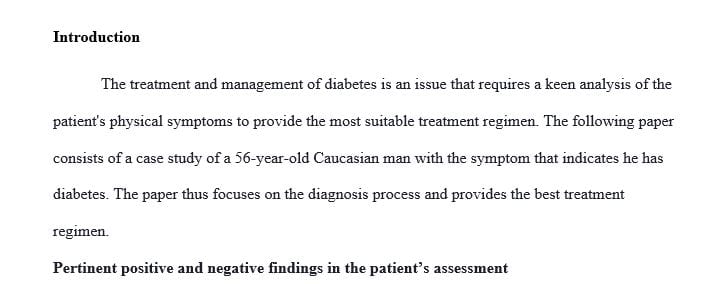What is the pertinent positive and negative findings in this patient assessment
Case Study for Chronic Condition
For this Assignment, you are answer the questions regarding this case study. Please make sure to support your answers using evidence based practice. (5 pages essay excluding title and reference page).
56 y/o Caucasian male presents to the primary care clinic with complains of dizziness and nausea x 4 days. The patient reports he has not been able to get out of bed since the symptoms started. The patient reports symptoms are worse when he tries to get out of bed to stand. He denies any headaches or blurry vision. He states he is urinating more over the last few days and he has noticed increase in thirst. He reports he just drank a large sweet tea before he came into the clinic.
The patient reports that he is out of his Lantus and metformin because he cannot afford the refill until he gets his disability check. He is disabled after his second CVA that left his with generalized weakness. His medical history includes DM, HTN, CAD.
Upon arrival at the clinic, the patient’s vital signs are as follows- Blood sugar 405, B/P 190/101, HR 102, R-20, T- 98.5.
Using Evidence Based practice, answer the following questions thoroughly. Be sure to use APA formatting.
What is the pertinent positive and negative findings in this patient assessment?
Create a list of differentials with rationales for this patient?
Discuss a medication regimen for this patient considering his financial status?
What is the priority concern for this patient?
How does this patient’s comorbid diagnosis impact his current symptoms?
Discuss how the patient’s’ health beliefs, culture and behaviors impact the potential outcomes for the patient.
follow the conventions of Standard English (correct grammar, punctuation, etc.);
be well ordered, logical, and unified, as well as original and insightful;
display superior content, organization, style, and mechanics; and
use APA 6th Edition format.
yes writer please pay extra attention to this unique assignment. this case study is worth heavy points.
good news is I have attach the file of sample essay of student who has gotten good grade on it….you can use most of the information from the sample essay and data/material for better understanding and research.
keep in mind professor will use software to check for similarities. so write in your own words.Hello Writer….This part of the sample essay you may use this information (differentials..physical exams,,,diagnostic exam) but write them different way with this given information…thx
Q2. List of differentials with rationales for this patient.
Differentials are medical diagnosis that correspond to billable ICD 10codes.
Type 2 diabetes mellitus with ketoacidosis E11.1
Type 1 diabetes mellitus with ketoacidosis E10.1
Hypertensive crisis I16
Diabetic (mellitus) (sugar) E11.9,Diabetes
Coronary atherosclerosis as a result of calcified coronary lesion I25.84
Atherosclerosis heart problem of native coronary artery w/o angina pectoris I25.10
Pure hypercholesterolemia E78.0 Weakness, late effect of stroke R53.1 Nausea and vomiting R11
Low income Z59.6
Lack of physical exercise Z72.3
Rationale
For this patient the concern would be Diabetic ketoacidosis (DKA) due to his recent blood sugar of 405 and his symptoms of thirst and urination are of concern. Because of such a condition, hyperglycemia sets in as a result of enhancement of glycogenolysis and hepatic gluconeogenesis. His symptoms of dizziness, nausea, increased thirst and frequent urination.
Physical Examination
Assess Cardiovascular, check pulse in the feet and thearms
Assess Respiratory
Assess GI
Assessment of Nervous System
Examination of feet, decreased sensation (numbness, tingling, pain-Neuropathy), injuries and sores.
Urinalysis regarding ketones
Eye checkup regarding retina and pupil response to light(yellow patches on the inside corners of your eyelids, made up of cholesterol indication of heart disease, cataract formation orophthalmoplegia
Even though he denies a headache or blurry vision. Assess visual acuity.
Order the following laboratory tests: blood glucose, blood ketones, urine ketones,venous blood gases, electrolytes, calcium, magnesium, phosphate, a complete blood count, and HbA1C.
A blood sugar level over 200 mg/dL
Ketone bodies in the blood above 31 mg/dL (> 0.3 mmol/L) or ketonuria more than80 mg/dL
Acute diabetic ketoacidosis = pH < 7.1
Mild diabetic ketoacidosis = pH about 7.2 ——————————
Random glucosetest.
CMP.
Maintenance of Normal blood pH is crucial to evoke effective tissue oxygenation… Acid Base bloodwork. CHEM-7 or a basic metabolic panel. Ph balance.
Observe skincondition
Check thyroidglands
(Weakness of one or more of the muscles that control eye movement).
Diagnostic Test
The diagnosis of diabetic ketoacidosis is a laboratory-based diagnosis. The following points summarize diagnostic criteria about diabetic ketoacidosis:
——————————
The severity of diabetic ketoacidosis is dependent on the pH value and bicarbonate concentration:
Solution preview for the order on what is the pertinent positive and negative findings in this patient assessment
APA
1546 words
